Beyond CXO readership: Why long-form content is great for the long haul

Even for the best of marketers, creating long-form content that is appealing and engaging seems like a daunting task. It is a significant effort and investment both for the creator and the reader in the era of ‘snackable’, short-form content formats. However, long-form content is increasingly helping content marketers to provide comprehensive information, add value and context, and offer critical insights that establish their brand’s authority and expertise. Contrary to popular perception, long-form content doesn’t simply increase your CXO readership or reach, it has wide-ranging benefits for your brand from better SEO to social media success and lead generation. If you haven’t created your long-form content strategy, here are some reasons why you should invest strategically in long-form to boost your marketing efforts:
Enhanced SEO
Long-form content is effective for each part of the sales funnel and essential to the pillar content strategy. Google’s complex algorithm ranks website content based on myriad factors. The search engine wants to ensure that the page it recommends demonstrates a high level of expertise, authority, and trustworthiness or in other words the E-A-T parameter that protects searchers from poor quality content. Google’s RankBrain algorithm sorts uses Artificial Intelligence to help understand what people mean when they type a query and the resultant user satisfaction.
The longer format helps creators to dive deep into a topic and offer solutions to user problems. When search engines recognize that searchers’ intent is being fulfilled by your content, the ranking improves, getting your content more front and center.
Longevity
Long-form content has a longer shelf-life and visibility. Pillar posts or cornerstone content that offer a detailed and comprehensive view of a topic tend to stay evergreen and seldom get outdated. It continues to attract traffic over the lifetime of your blog or website. Once you have built a solid piece of content, all you need to do is ensure it is updated regularly with new information where relevant. It is also ideal for content atomization so marketers can take chunks of content from a pillar post or cornerstone content and spread it far and wide using different formats.
Improves social sharing
The longer the content piece, the more you need to reference high-authority articles, blog posts, and websites in the long-form article to support your information. The cross-referencing supports the link-building efforts of several authors and publishers who have created the original content. This leads to an enhanced sharing cycle where you can tag your original references in tweets or LinkedIn posts and they, in turn, follow suit. Moreover, since longer content pieces are more nuanced with critical insights, statistics, quotable quotes, and images, they are inherently share-worthy. People will find nuggets of wisdom throughout the content that they can reuse and share. Moz, the search engine expert researched more than one million articles and concluded that “long-form content gets higher average shares and significantly higher average links.”
Lead generation and funnel creation
Comprehensive pieces of content offer an educational experience for the target audience. Readers can derive more value from longer pieces in a matter of minutes. But additionally, long-form content helps build highly converting landing pages. Especially in the B2B realm, many marketers use their long-form content pieces to funnel site visitors to the “money pages” of the website or the ones that matter the most to your business. The key is to add CTAs that guide the users to the next step whether it is a download or a free trial. Long-form content provides many opportunities to direct the user to a helpful, next step beyond the content itself.
Building reputation, authority, and trust
Often the purpose of a long-form guide or blog post is to identify emerging trends and technologies, offer analysis and insights and present a unique angle or view to a topic that’s popular. It feeds the interests and passions of the target audience and often provides solutions to specific customer challenges.
If you are able to identify relevant topics, research well and create unique and thought leadership content pieces, you can build utility and reputation as a trusted resource in your domain. This goes a long way in bolstering your brand authority and expertise not just within your core audience but within the wider network of competitors.
For instance, HelpScout has used lengthy guides that focus on various aspects of customer service to position them as a knowledgeable educator and an authority in the customer service space.
How to do long-form right?
The ideal length is anywhere between 1200-4000 words or beyond. But word count is just one parameter, the topic should merit the length and should be finely nuanced with rich information, data, examples and multimedia such as images and graphs. Include helpful responses to frequently asked and nuanced questions or complexities of a topic. Use the right amount of topical deep-dive, storytelling and keywords to make the piece informative without being boring or repetitive.
If you take the above tips into consideration, you are more likely to produce contextual content that attracts visitors, improves SEO, and delivers longer-term value that goes beyond CXO readership.
Relevant Links:
https://scatter.co.in/scatter-calendar-april-2021-2/
https://scatter.co.in/martech-innovations-that-will-shape-the-new-digital-decade/
Contributors: Sadaf, Sanchea, and Swapnil
